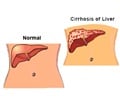
Until recently, the growth of fat deposits in the liver that characterizes fatty-liver disease was mainly considered a result of alcoholism. Over the last decade, though, scientists have been baffled by the rising incidence of the non-alcoholic version of the disease, which now affects as many as one in four people worldwide, according to UCSF cardiologist Ethan Weiss, MD, senior author of the paper.
Known risk factors for the condition include obesity, diabetes and malnutrition, among many others, but its precise mechanism had eluded researchers.
"Fatty liver disease is an increasingly prevalent condition that is poorly understood," Weiss said. "We knew that growth hormone had been linked to fatty liver, but previous reports showed that it both causes and cures the condition. We set out to figure out why that happens."
The team focused on a protein in the liver known as JAK2. While better known as being linked to cancers such as blood cancers, this protein is also a key player in an important chemical pathway in the liver.
Normally, the pituitary gland secretes growth hormone, which communicates with JAK2 and sets off a series of steps to produce insulin-like growth factor 1 (IGF-1), an important mediator of growth and other effects. It was common knowledge that disrupting this pathway would halt IGF-1 production, but in their analysis, Weiss and his team found that disrupting the pathway also caused fatty liver disease.
Advertisement
The amount of growth hormone secreted by the pituitary gland also was dramatically elevated. The team realized that low IGF-1 levels were sending the pituitary gland into overdrive, secreting more growth hormone in order to jumpstart the growth factor's production. But without JAK2, the signaling pathway was broken and IGF-1 production was at a standstill.
Advertisement
"We saw a complete disappearance of the fatty liver in these offspring," he said. "It was just gone."
The team concluded that the growth hormone signaling pathway is not only essential in producing IGF-1 and mobilizing fat, but in regulating how fat is taken up by the liver.
This new found understanding has huge implications for understanding and treating fatty liver disease in humans, Weiss said, such as the possibility of developing a therapeutic drug that works within this pathway.
Source-Eurekalert















